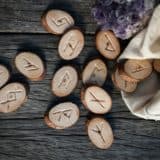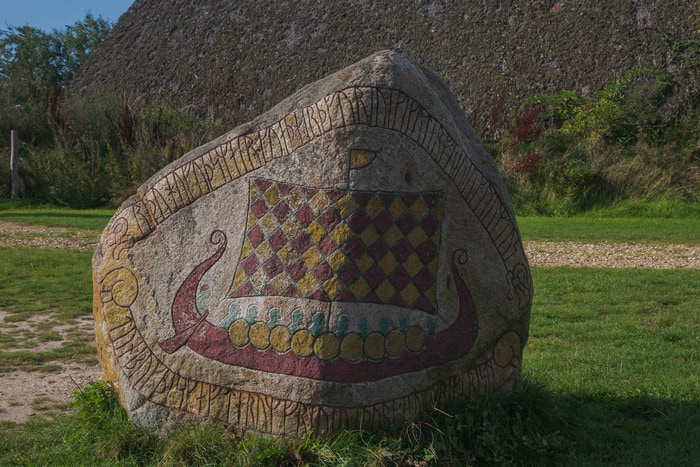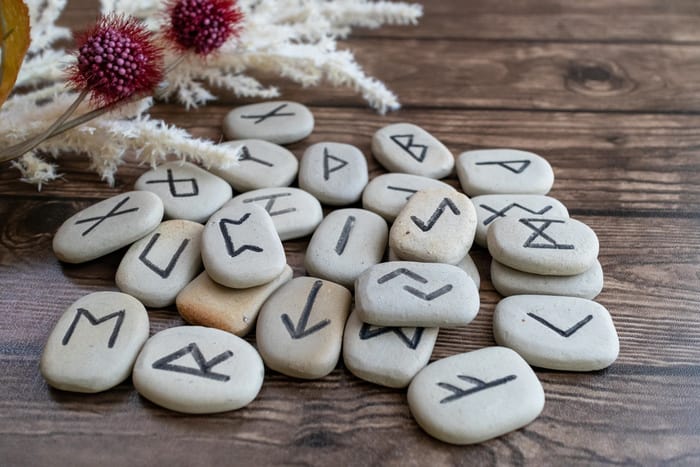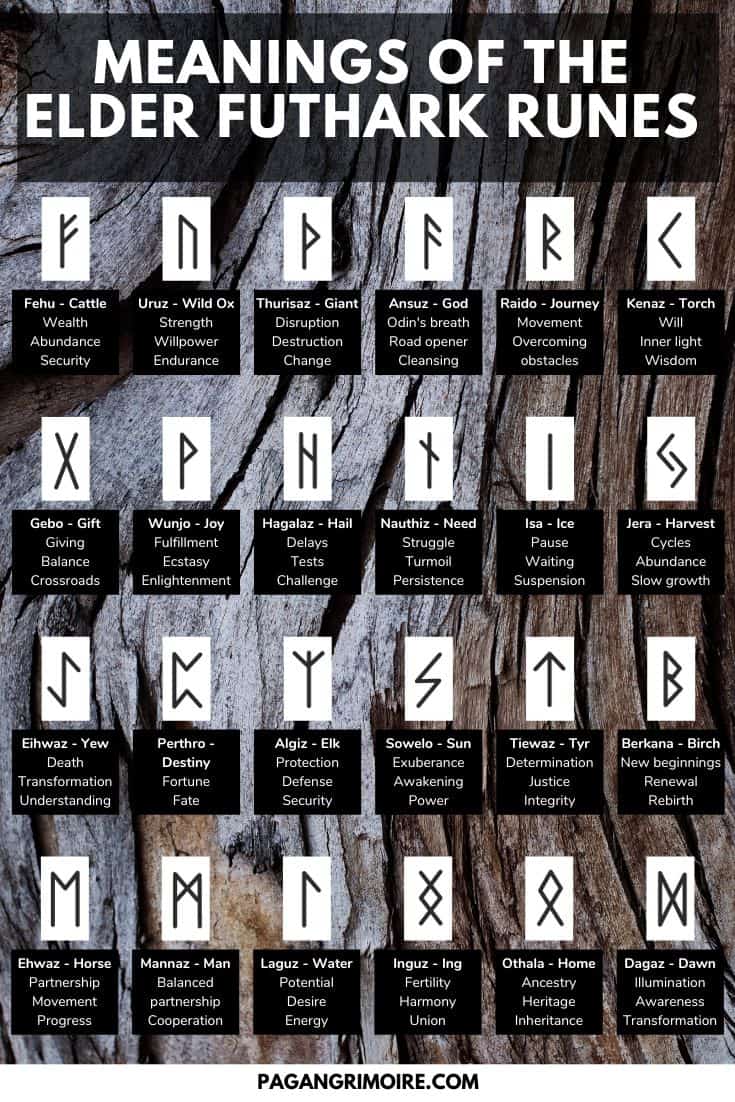The 24 Elder Futhark Runes and Their Meanings
Your look at the ancient writing system and divination tool.
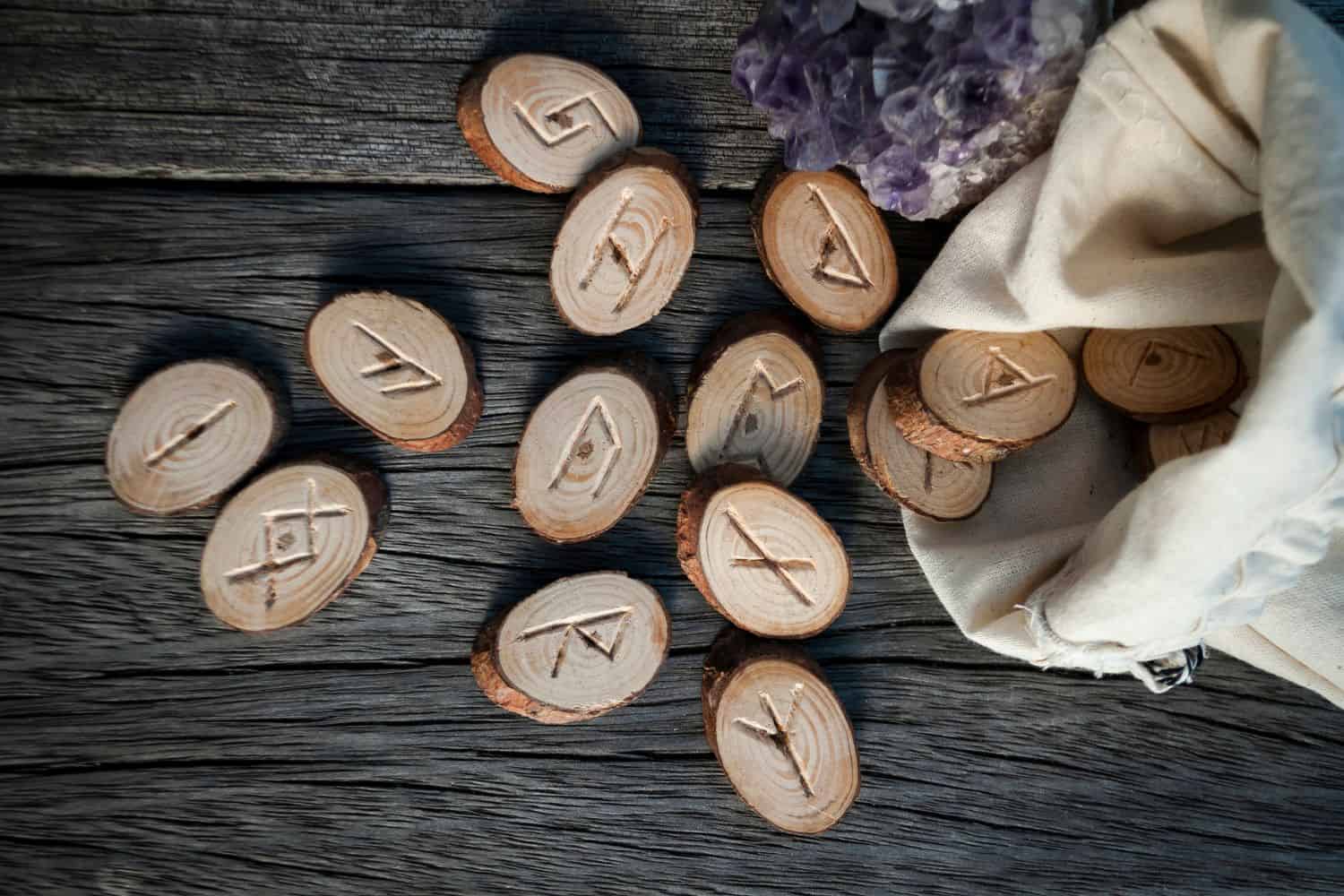
As an Amazon Associate we earn from qualifying purchases. This post may contain affiliate links from Amazon and other sites that we collect a share of sales from. You may learn more here.
Ever since I was a kid, I was fascinated by runes. I think I first stumbled upon them within Lord of the Rings. The characters felt mystical, otherworldly. Later on, I learned a bit more about their history and the meanings of the different Elder Futhark runes.
Below are the different meanings for each of the 24 runes. If you want your own set, here is an obsidian one.
What Are Runes?
Runes are an alphabet developed and used by the Germanic peoples. The oldest known runes are the 24 Elder Futhark runes which date back to the 1st century CE. Their origin is lost to history, but some believe they might be based on the ancient Italian writing style Old Italic. But, the word “rune” comes from the Proto-German word runo or Old Norse run, meaning “a secret, magic sign, runic character.”
These days, we seem to primarily associate runes with the Norse and the Vikings, but they were used throughout Scandinavia as a way to convey ideas, messages, and perform magic or divination.
The script evolved over the centuries, but from the Elder Futhark to the Medieval Futhark in 13th century, the style remained essentially the same. Most of the runic letters are made from a vertical line that have other lines or curves attached to them.
The Vikings used Younger Futhark, which has 16 letters. There are two writing variations of Younger Futhark style, the long branch and the short twig. The long branch style is attributed to Danish, while the short twig is connected to the Swedes and the Norse. The Vikings used both.
The Three Aetts of the Elder Futhark
The 24 Elder Futhark Runes are sometimes arranged in three groups, known as ætts. “Aett” is Old Norse for family, generation, or quarter of the heaven. According to The Complete Illustrated Guide to Runes by Nigel Pennick, each ætt is named for the Norse god or goddess that rules them.
Freyr and Freyja’s Aett
The first eight runes of the Elder Futhark is ruled by Freyr and Freya’s (or Freyja). These runes represent the things that happens in the physical world. Namely, creation, war, prosperity, virility, and love. The runes in Freya’s ætt are Fehu, Uruz, Thurisaz, Ansuz, Riadho, Kenaz, Gebo, and Wunjo.
Heimdall and Mordgud’s Aett
The second set of eight runes are ruled by Mordgud and Heimdall (also known as Hagalaz or Hagal). These runes represent change, the underworld, and the unconscious mind. It takes us through the time that Odin died on the tree for the runes and his rebirth. These runes represent beginnings and endings, chaos, destruction, or the seasons. The runes in Heimdall’s ætt are Hagalaz, Nauthiz, Isa, Jera, Eihwaz, Pertho, Algiz, and Sowelo.
Tyr and Ziza’s Aett
The third set of eight runes are ruled over by Tyr and Ziza. These runes connect to spirituality, emotions, and how we interact with the world. The runes in Tyr’s ætt are Tiwaz, Berkana, Ehwaz, Mannaz, Laguz, Inguz, Dagaz, and Othala.
Elder Futhark Rune Meanings and Symbols
1. Fehu ᚠ — Cattle
Fehu means “cattle,” but it represents the concept of abundance, wealth, security, and fertility. If you owned cattle (or your cattle were doing well), this could be a sign of prosperity.
Keywords: abundance, good fortune, wealth, security, success
2. Uruz ᚢ — Wild Ox (Aurochs)
Uruz means “wild ox” and like the intensity of a bull, it represents determination, courage, will, vitality, primal power, manifestation, and endurance.
Keywords: strength, willpower, endurance, determination, courage
3. Thurisaz ᚦ — Giant
Thurisaz has a few different translations. In the Old Norse, it translates to “giant.” But, in the Old English, it translates to mean “thorn.” In divination, it’s indicative of an intense change or, sometimes, danger. It represents a powerful, disruptive force that shakes things up, similar to the lightning that Thor controls with the Mjolnir.
Keywords: disruption, change, destruction, obstacle clearer, wildness, lust, rage
4. Ansuz ᚨ — God
Ansuz means “god,” but it represents the breath of Odin. Though, in the Old Norse rune poem, it’s literally translated to mean estuary, which is where a body of water meets the ocean. Similarly, this rune symbolizes the awakening the often precedes deep spiritual work and can help release stuck energy.
Keywords: door opener, expansion of consciousness, remover of blockages, cleansing
5. Raidho ᚱ — Journey
Raido means “journey.” It’s also sometimes translated to mean riding or wagon. Spiritually, it represents the movement forward after the dark night of the soul or an intense spiritual awakening. Practically, it’s a decision to move forward on your journey with a specific action. Though, it might also literally represent travel.
Keywords: movement, overcoming obstacles, forward momentum, travel
6. Kenaz ᚲ — Torch
Kenaz means “torch.” It essentially means to illuminate something or to take the first step to manifest something into existence. Within the self, it’s the inner light or sense of purpose that drives one forward. When we are without it, we feel like we are fumbling through the darkness.
Keywords: manifestation, will, divine spark, light within, guidance, inner wisdom
7. Gebo ᚷ — Gift
Gebo means “gift” or “exchange.” It symbolizes the power of gratitude begetting more generosity and the energy that occurs when there is an exchange of gifts. The rune is literally a crossroads, made of two branches crossing one another, and in that moment, there is a union, just as when a gift is given from one to another. It serves as a reminder to be grateful, but also that every interaction involves an exchange of energy. When cast, it may also symbolize the need for energetic or spiritual balance.
Keywords: giving, balance, union, energy or power exchange, crossroads, partnership
8. Wunjo ᚹ — Joy
Wunjo means “joy.” It symbolizes that moment of intense ecstatic expansion when all comes into alignment and the world feels charged. It also represents moments of happiness, fulfillment, and prosperity.
Keywords: fulfillment, ecstasy, moment of spiritual enlightenment, flow state
9. Hagalaz ᚺ — Hail
Hagalaz means “hail,” like the hailstone. Some see it intense like wrath, while others feel it represents being tested and that it could be symbolic of the dark night of the soul. Depending on where you are in your spiritual journey, this could indicate it’s a time for shadow work. Or, that it is a good time to pause and contemplate things from another viewpoint before continuing. It represents the first rune of the next series and the descent into the underworld.
Keywords: obstacles, challenges, delays, temporary delays, tests, dark night of the soul, spiritual descent
10. Nauthiz ᚾ — Need
Nauthiz represents “needs” in the sense of struggle and want. It symbolizes a time when you are ignorning your needs or when you are distressed because your needs are not met. Only you will know which one it is. It is an indicator to look at what needs are going unmet and what rebalancing or internal work must take place. It also may symbolize your resilience in the face of emotional turmoil and determination to continue forward on the path.
Keywords: yearning, lack, struggle, turmoil, persistence, determination, resilience
11. Isa ᛁ — Ice
Isa symbolizes “ice” or being frozen. It is the time when you are unable to move forward. This could mean spiritually or it could mean more literally if in regards to a project, plan, or relationship. This is an indicator that things have been put on hold and it is time to go within. If things have been overflowing in a negative way, it could also represent the need for boundaries.
Keywords: Pause, waiting, delay, suspension
12. Jera ᛃ — Harvest
Jera represents the “harvest.” In contrast to Isa, it represents the time when you can enjoy the fruits of your work. It is a reminder that there is a cycle or process to all things.
Keywords: cycle, abundance, harvest, slow growth, extension, process
13. Eihwaz ᛇ — Yew
Eihwaz is the word for “ash or yew tree,” but it’s mean to symbolize Yggradsil, the central sacred tree of Norse mythology. The tree has represented death for various cultures, but can also mean the death of outdated beliefs and the healing and transformation that might follow knowledge.
Keywords: death, transformation, understanding, transition, life cycle
14. Perthro ᛈ — Dice Cup
Perthro represents “fortune.” The underlying concept here is that once you know your current destiny, it’s up to you to decide what to do with it. Do you stay on the path that will take you in that direction or do you adjust course to try and alter the outcome? What has your reading revealed to you that you might want to consider working on?
Keywords: fortune, fate, chance, mystery, the occult, the unknown, the beyond, destiny
15. Algiz ᛉ — Elk
Algiz symbolizes the “elk” but in the sense of protection. It’s a rune that reminds you to stand your ground or that you might need to do so. It could also come up when you need some extra help from the gods when facing a challenge.
Keywords: defense, protection, grounding, strength
16. Sowelo ᛋ — Sun
Sowelo represents the “sun” and the awakening it provides. If you’ve been struggling through a dark night of the soul, this rune represents warmth and restorative, healing energy so that you can move forward towards what you are meant to do.
Keywords: awakening, exuberance, healing energy, victory, power
17. Tiewaz ᛏ — Tyr
Tyr represents the warrior god, Tyr. When cast, the rune symbolizes determination, doing the right thing, persistence in the face of obstacles, and detached discipline unswayed by the pull of emotion, and self-mastery. It might suggest you need to reconnect with your power or purpose and become your own leader.
Keywords: determination, justice, self-mastery, discipline, integrity, leadership
18. Berkana ᛒ — Birch
Berkana symbolizes the birch tree and new beginnings. Unlike some other runes, Berkana represents a gentle rebirth or renewal. It can suggest that healing growth or change is coming or needs to be done. It also represents the conscious decision to manifest something onto the physical plane.
Keywords: healing, manifestation, rebirth, new beginnings, growth, renewal, nurturing
19. Ehwaz ᛖ — Horse
Ehwaz represents the “horse” that allows for messages and communication to occur, for someone to travel between worlds or states, and for steady forward progress. It also symbolizes the harmony and trust between two different beings.
Keywords: partnership, connection, movement, harmony, trust, loyalty, progress
20. Mannaz ᛗ — Man
Mannaz symbolizes “man,” in the sense of humankind. It represents your social community and how you work within it. If you’ve been isolating, it might suggest your need for more of it. It also represents the ideal partnership: one of equal give and take, healthy boundaries, and the tending to both the self and the other.
Keywords: balanced partnership, healthy boundaries, cooperation, friendship, community
21. Laguz ᛚ — Water
Laguz translated to mean “water,” but it really represents the intense power and rolling force of the element. It’s more like the power of the waterfall or the ocean versus the gentle stream. Though, that said, even the rocks within the stream are eventually worn down by the flow of water. It can help you flow and work with the energies in order to manifest into being that which you desire.
Keywords: harnessing energy, power, movement, potentiality, manifestation, flow, desire
22. Inguz ᛝ — Ing
Inguz stands for the god Ing. It symbolizes fertility, sexuality, intensity, and the door leading home. It can help with emotional renewal or spiritual healing work. Also, it could represent the buried seed that is being nurtured before it can sprout.
Keywords: fertility, sexuality, harmony, emotional healing, balance, seed, potential
23. Dagaz ᛞ — Day
Dagaz represents “dawn” or day. It marks the ending of one cycle and the beginning of the next. It also symbolizes the spiritual awareness and transformation that comes with this.
Keywords: change, illumination, awareness, transformation
24. Othala ᛟ — Home
Othala represents “home” or “wealth,” but in the sense of family. It symbolizes the importance of those around you, of a strong foundation to build off of, and your connection to the past.
Keywords: ancestry, heritage, history, foundation, inheritance

